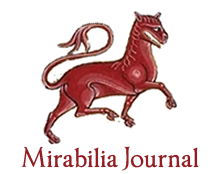The concept of contemplation in medieval monastic education: reflections on Bernard of Clairvaux
Terezinha OLIVEIRA, Rita de Cássia PIZOLI
Original title: O conceito de contemplação na educação monástica medieval: reflexões sobre Bernardo de Claraval
Published in Monastic and Scholastic Philosophy in the Middle Ages
Keywords: Bernard of Clairvaux, Cistercians, Monastic Education.
This article reflects on the thought of Bernard of Clairvaux (1090-1153) in order to understand the dynamics of the Cistercian monastic education and its influence in the educational process in century XII. In light of social history, the first part presents some aspects of the social structures of medieval christian west, relating the broader context with the Cistercian monastic reform proposal that forwarded the Church for an important moment against the temporal power, with Pope Innocent III (1198-1216). Bernardo of Clairvaux became a part key of the church reform that was in course, from the gregorian reform and has in contact with all the importants points of the conflicts politicians of its time. Its letters and its writhings disclose the dynamics between action and contemplation that if became its life and, by means of them, we can perceive the influence in the direction of the society, that if wants guided in the values of the authenticity of the love, conscience of itself, taste for the pureness spiritual and the affirmation of the dignity of the man as image and similarity of God. This vision Christian humanist and the valuation of the knowledge as conscience of itself, were the basis for the mystical movement developed by the Cistercians. Finally, the text presents reflections on the Sermon on the Vigil of Christmas to explain the devotion to the humanity of Jesus as one of the theological basis for learning the route of ascent to contemplation, as understood by the monks developed psychic ability to achieve affection and unity between reason.
The configuration of the beloved body in medieval romance: idealization and eroticism in Le Chevalier de la charrette by Chrétien de Troyes (c. 1135-1185)
María ESTRELLA
Original title: La configuración del cuerpo amado en el roman medieval: idealización y erotismo en El caballero de la Carreta de Chrétien de Troyes (c. 1135-1185)
Published in The Medieval Aesthetics
Keywords: Body, Chrétien de Troyes, Medieval romance, Wound.
The main purpose of this article is to analyse the configuration of the body in Le Chevalier de la charrette (1176/1181), written by Chrétien de Troyes, which narrates the adulterous love of Lancelot and Queen Geneva. We are interested in observing the survival of the doctrine of courteous love in the construction of the chivalrous hero and the character of the beloved woman, who is worshiped as a superior being. A "religion of love" is outlined, which, according to Denis de Rougemont, is one of the axes that articulates this doctrine. At the same time, this idealization is combined with the physical presence of the body, especially in the description of the sexual encounter of the couple. We will explore a conception of love that is delineated as pleasurable suffering and characterized by an eroticism that combines joy and pain, which is represented in the topic of the wound.
The contribution of Ernesto Salles Cunha for paleopathology in the State of Espirito Santo, Brazil
Henrique Antônio VALADARES COSTA, Patrícia D. DEPS
Original title: A contribuição de Ernesto Salles Cunha para a paleopatologia no Estado do Espírito Santo, Brasil
Published in
Keywords: Archeology, Ernesto Salles Cunha, Paleopathology, Prehistory, Sambaquis.
Ernesto de M. Salles Cunha (1907-1977) was Professor of Dentistry School at the Universidade Federal Fluminense and set his life as an enthusiast of the Brazilian history of health, more precisely about the history of dental health and the development of archeology in Brazil. This article demonstrates the importance of the researcher presence in the Capixaba`s territory contributing with the studies about the dental paleopathology of the Sambaquis population in the State of Espirito Santo.
The control of the bodies in The Physician’s Tale and The Wife of Bath’s Tale by Geoffrey Chaucer (c. 1343-1400)
Candela ARRAIGADA
Original title: El control de los cuerpos en The Physician’s Tale y The Wife of Bath’s Tale, de Geoffrey Chaucer (c. 1343-1400)
Published in The Medieval Aesthetics
Keywords: Arthurian subject, Canterbury Tales, Control over the Body, Literature of the Middle Ages.
In Una historia del cuerpo en La Edad Media (2005), Jacques Le Goff and Nicolas Truong point out that the oscillations between rejection and exaltation, humiliation and veneration, cross the medieval Christian body. In line with this approach, our paper aims to examine two stories belonging to The Canterbury Tales, by Geoffrey Chaucer, in which the conflicts between old age and youth are glimpsed, articulated mainly around the ideals of virginity and chastity, which reveal the links between eroticism and control over bodies. Both stories will establish a counterpoint between two models of women. The Physician’s Tale offers a paradigmatic perspective of the physical and psychic virtues of a young woman and reveals the absolute value given to virginity. On the other hand, in The Wife of Bath’s Tale the Arthurian subject and the structure of the quest will serve the analysis of the power relationships between oldness / ugliness and youth / beauty, in intimate relation with the Prologue that precedes it, focused on the modern notion of experience.
The definition of religion in Saint Augustine (354-430), a man of the Mediterranean
Luís Carlos Silva de SOUSA
Original title: A definição de religião em Santo Agostinho (354-430), homem do Mediterrâneo
Published in Intercultural Mediterranean
Keywords: God, Religion, Saint Augustine, Transcendence, Truth.
Language:
The objective of this article is to analyze Saint Augustine’s definition of religion in De uera religione (LV, 113). Two central aspects are highlighted: 1) religion understood as religatio with the one omnipotent God, and 2) a relationship between the human mind and Truth, with the inner light playing a central role. Interiority constitutes a privileged access to God’s transcendence.
The difficulty in distinguishing beauty and art in some medieval expressions
Susana BEATRIZ VIOLANTE
Original title: La dificultad en la distinción de belleza y de arte en algunas expresiones medievales
Published in The Medieval Aesthetics
Keywords: Art, Beauty, Perspective in art, Philosophical perspective, Ugliness.
To flee from common places, it would be necessary to determine what is understood as beauty, distinguishing how this concept has been modified in relation to geographical space, periods of historical time and what the different centers of power have instituted as such. Something extremely complex because, fundamentally, I consider that it cannot be defined beyond than what generates an “aesthetic” tension that drives us to say: how nice!!! How ugly!!! But this “tension” is crossed by a whole discourse that makes us distinguish the beautiful and the ugly as such. What do we think of art in the medieval period? Because classical Greek art is still “seen” in many works, especially from Renaissance, modern and even contemporary, but we do not find the different perspective with which the medieval has expressed itself, with that recognition - and it does not seem to interest too much “See” - although, its superposition of close and distant planes - I - dare to find them stylized? in some of Picasso’s, Kandinsky’s, Magritte’s works ... I know it might seem “crazy” what I say, but here go certain images.
The dignity of the body, of woman, of love and pleasure. Brief analysis in the great humanist works of the Crown of Aragon
Júlia BUTINYÀ
Original title: La dignitat del cos, de la dona, de l’amor i del plaer. Breu anàlisi en les grans obres humanistes de la Corona d’Aragó
Published in Rhythms, expressions and representations of the body
Keywords: Commedia, Curial e Güelfa, Decameron, Lo somni.
This observation aims to outline quantitative nuances about the notion of the body and senses from the great humanist works of the Crown of Aragon: The dream of Bernat Metge (1399) and the Curial and Güelfa (ca. 1458), for the purpose of approach the evolutionary line of the Humanism since the beginning. It demands to go back to the literary sources and the ascendancy of that ideological renewal, which will lead to Dante. This route is of interest to follow the first humanist achievements, of which we obtain very pure samples in these Italo-Catalan origins, marked by a stamp of mixture, sensual and moral, that characterizes them. Finally, we will conclude by pointing out the fleetingness of the humanistic purity that these two works contain.
The doctrine of Jacob of Serugh on conceptio per aurem as a possible literary source in medieval iconography of The Annunciation
José María SALVADOR GONZÁLEZ
Original title: La doctrina de Jacob de Sarug sobre la conceptio per aurem como posible fuente literaria en la iconografía medieval de La Anunciación
Published in
Keywords: Conceptio per aurem, Iconography, Jacob of Serugh, Mariology, Medieval Art, Patristics, The Annunciation, Theology.
This paper focuses the attention on the possible influence that the thinking of the Syriac theologian Jacob of Serugh on conceptio per aurem might have had on late medieval representations of the Annunciation. Therefore, after explaining the doctrine of this Oriental thinker by explaining many passages of his writings, ten pictorial images of this Marian theme in which you could glimpse such influence are analyzed. While underlining the prestige of this great writer of Serugh and the wide dissemination of his works during the Middle Ages, the author also emphasizes that the interpretation given in this paper is only a mere conjecture that, even if it looks plausible, is susceptible of enrichment, correction and even rejection, if reliable documentary evidence so require.
The enemy and the foreigner in Egyptian art: an iconographic study
Ana DIEZ FLÓREZ
Original title: El enemigo y el extranjero en el arte egipcio: un estudio iconográfico
Published in
Keywords: Ancient Age, Defeat, Egypt, Enemy, Foreigner.
In the following paper an aproximation to the concept of enemy in the Ancient Egypt is done: how and when it appeared, how it is identified and how it is representated in egytian art. Regarding the artistic representations, there are many in which egytian and foreigner enemies are shown being controlled and beaten by the pharaoh in various ways or defeated in battle. The foreigner, besides appearing deafeted shows an atitude of redemption and submision.
The face as the place of the subject that existed: artistic figurations from Antiquity to Baroque
Alexandre Emerick NEVES
Original title: O rosto como lugar do sujeito que houve: figurações artísticas da Antiguidade ao Barroco
Published in Rhythms, expressions and representations of the body
Keywords: Antiquity, Baroque, Face, Presence and Absence.
Generally, when we refer to human representation, we immediately remember the human body, the human figure, and when we deal with the subject, the first reference is his face or, more specifically, his portrait. It is interesting to remember, in this regard, that the face itself can be fragmented, divided into significant, if not autonomous, parts. Without intending to go through an exhaustive and linear history of the face, consenting to jumps and returns between Antiquity and the Baroque with some providential escapes, I turn to Giorgio Agamben regarding the asymmetrical relationship between the head and the body, while Georges Didi-Huberman and Jacques Rancière help us on the affinity of the images of figured bodies with the presence or absence of the subject, especially in the face.






















































































